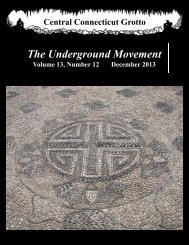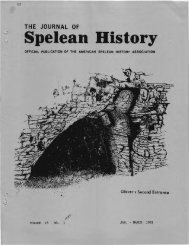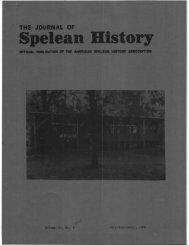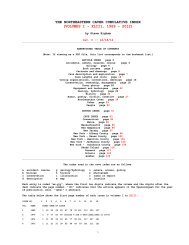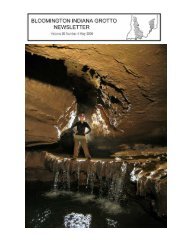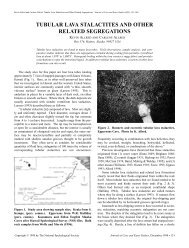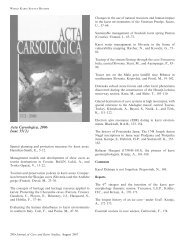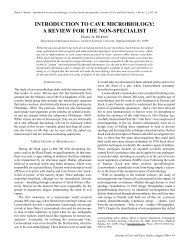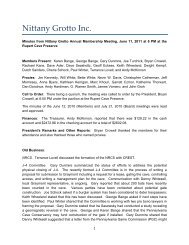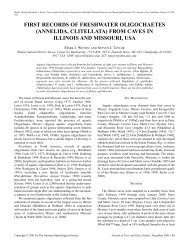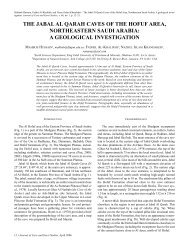Eyed Cave Fish in a Karst Window - National Speleological Society
Eyed Cave Fish in a Karst Window - National Speleological Society
Eyed Cave Fish in a Karst Window - National Speleological Society
You also want an ePaper? Increase the reach of your titles
YUMPU automatically turns print PDFs into web optimized ePapers that Google loves.
Luis Esp<strong>in</strong>asa and Richard Borowsky - <strong>Eyed</strong> <strong>Cave</strong> <strong>Fish</strong> <strong>in</strong> a <strong>Karst</strong> W<strong>in</strong>dow. Journal of <strong>Cave</strong> and <strong>Karst</strong> Studies 62(3): 180-183.<br />
EYED CAVE FISH IN A KARST WINDOW<br />
LUIS ESPINASA<br />
CEAMISH, Universidad Autonoma del Estado de Morelos, Av. Univ. #1001, col. Chimalpa, Cuernavaca, Morelos, MEXICO<br />
RICHARD BOROWSKY<br />
New York University, Department of Biology, 1009 Ma<strong>in</strong> Build<strong>in</strong>g, Wash<strong>in</strong>gton Square, NY 10003. USA<br />
Caballo Moro, a karst w<strong>in</strong>dow cave <strong>in</strong> northeastern Mexico, supports a mixed population of cave<br />
Astyanax mexicanus: eyed and eyeless. The relationships of these sub-populations to one another and to<br />
other populations of Mexican tetras were exam<strong>in</strong>ed us<strong>in</strong>g RAPD DNA f<strong>in</strong>gerpr<strong>in</strong>t markers. The eyed<br />
tetras of Caballo Moro <strong>Cave</strong> are genetically closer to bl<strong>in</strong>d tetras from Caballo Moro and other caves <strong>in</strong><br />
the region than they are to eyed tetras from the surface. The two forms are not genetically identical, however,<br />
and may represent dist<strong>in</strong>ct sub-populations.<br />
<strong>Eyed</strong> and eyeless fish have a distributional bias <strong>in</strong> the cave, with eyed fish preferentially <strong>in</strong> the illum<strong>in</strong>ated<br />
area and bl<strong>in</strong>d fish <strong>in</strong> the dark zone. Aggression of eyed towards bl<strong>in</strong>d fish <strong>in</strong> the illum<strong>in</strong>ated area<br />
contributes to this bias and may serve to stabilize the eye-state polymorphism.<br />
We considered four hypotheses for the orig<strong>in</strong> of Caballo Moro eyed cave fish. The RAPD data rule out<br />
that the mixed population represents a transitional stage of evolution, or that the eyed fish are unmodified<br />
surface immigrants. We cannot rule out that the eyed fish are the direct descendants of surface fish<br />
that have acquired markers from bl<strong>in</strong>d fish by hybridization, although the apparent dist<strong>in</strong>ctness of the two<br />
sub-populations suggests otherwise. An alternative hypothesis, that the eyed fish of the cave are direct<br />
descendants of bl<strong>in</strong>d cave fish that re-acquired eyes with the open<strong>in</strong>g of the karst w<strong>in</strong>dow, is consistent<br />
with the data and tentatively accepted.<br />
The Mexican Tetra, Astyanax mexicanus, is a visually orient<strong>in</strong>g,<br />
school<strong>in</strong>g fish widely distributed <strong>in</strong> surface streams of<br />
northern Mexico. In addition to the epigean populations,<br />
numerous cave forms of this species occur <strong>in</strong> the Sierra de El<br />
Abra region of northeast Mexico (Fig. 1; Mitchell et al. 1977).<br />
In contrast to the surface fish, these troglobitic forms have<br />
rudimentary, non-functional eyes, and their melan<strong>in</strong> pigmentation<br />
is reduced or absent.<br />
Generally, caves with troglobitic Mexican tetras do not<br />
conta<strong>in</strong> eyed tetras, except for the occasional doomed <strong>in</strong>dividual<br />
swept underground. One exception is El Sótano de El<br />
Caballo Moro, which conta<strong>in</strong>s an apparently stable, mixed<br />
population of A. mexicanus, both eyed and eyeless.<br />
The entrance of Caballo Moro <strong>Cave</strong> (CMC) is a karst w<strong>in</strong>dow.<br />
<strong>Karst</strong> w<strong>in</strong>dows are habitats with<strong>in</strong> cave systems that are<br />
exposed to light, and typically result from cave passage collapse.<br />
The 50-m deep entrance pit of CMC is found at the bottom<br />
of a 60-m dol<strong>in</strong>e, and leads directly to a large “lake” of<br />
approximately 18 m x 90 m. (<strong>Cave</strong> “lake” <strong>in</strong> this case, is a wide<br />
stream pool). Light reaches only the upstream half of the lake,<br />
while the downstream half rema<strong>in</strong>s <strong>in</strong> darkness. The lake conta<strong>in</strong>s<br />
both bl<strong>in</strong>d depigmented and eyed pigmented forms of A.<br />
mexicanus. The distribution of fish <strong>in</strong> the lake appears to be<br />
biased, with over-representations of bl<strong>in</strong>d fish <strong>in</strong> the dark area<br />
and eyed fish <strong>in</strong> the light area.<br />
Mitchell et al. (1977) observed that the source of the eyed<br />
fish of Caballo Moro cave was a mystery. The cave’s entrance<br />
pit is 11 km away from the nearest potential resurgence and<br />
does not capture a surface stream. Furthermore, there is no per-<br />
manent water nearby. The nearest recorded surface fish locality<br />
<strong>in</strong> the Río Boquillas system is 4 km distant. They hypothesized<br />
that seasonal flood<strong>in</strong>g of Río Boquillas tributaries affords<br />
occasional access to the cave through, as yet undetected, s<strong>in</strong>ks.<br />
As part of a larger study of the evolutionary history of the<br />
Mexican cave tetra, we <strong>in</strong>vestigated the relationships of the<br />
eyed fish of CMC. If they represent an unmodified surface<br />
population recently captured from a nearby s<strong>in</strong>k, their presence<br />
<strong>in</strong> the karst w<strong>in</strong>dow would be unremarkable. If, on the other<br />
hand, the population were of long stand<strong>in</strong>g, it would raise the<br />
question of the ma<strong>in</strong>tenance of its <strong>in</strong>tegrity <strong>in</strong> the face of<br />
potential hybridization with, and <strong>in</strong>trogression of genes from,<br />
the troglobites. Alternatively, if the eyed fish of the cave orig<strong>in</strong>ated<br />
from bl<strong>in</strong>d cave progenitors, they would make a good<br />
model for study of the effects of the reversal of selection pressures<br />
on populations.<br />
MATERIALS AND METHODS<br />
The relationships among representative surface and cave<br />
populations of Astyanax mexicanus from the El Abra region<br />
were studied us<strong>in</strong>g RAPD data. RAPD (synonymous with AP-<br />
PCR) technique generates a DNA f<strong>in</strong>gerpr<strong>in</strong>t from genomic<br />
DNA us<strong>in</strong>g the polymerase cha<strong>in</strong> reaction (Welsh &<br />
McClelland 1990; Williams et al. 1990). RAPD f<strong>in</strong>gerpr<strong>in</strong>ts<br />
are species and population specific and carry significant<br />
amounts of taxonomic <strong>in</strong>formation (Borowsky et al. 1995).<br />
The follow<strong>in</strong>g populations were sampled (Fig. 1): caves:<br />
Mol<strong>in</strong>o, Vasquez, and Caballo Moro: surface: Río Frío, Río<br />
180 • Journal of <strong>Cave</strong> and <strong>Karst</strong> Studies, December 2000 Copyright © 2000 by The <strong>National</strong> <strong>Speleological</strong> <strong>Society</strong>
Figure 1. Map of the Sierra de El Abra region show<strong>in</strong>g the<br />
collection sites. 1) Caballo Moro cave, 2) Mol<strong>in</strong>o cave, 3)<br />
Vasquez cave, 4) Río Subterraneo cave (a “Micos” cave), 5)<br />
the Río Frío surface locality at the Nacimiento de la<br />
Florida, 6) a surface locality <strong>in</strong> the Río Boquillas system,<br />
1 km upstream of La Servilleta canyon, and 7) the Río<br />
Comandante surface locality, just upstream from its confluence<br />
with the Río Frío . Other caves <strong>in</strong> the area are<br />
shown as unlabeled solid circles. (Redrawn from Wilkens<br />
1988.)<br />
Boquillas and Río Comandante. Astyanax aeneus from the Río<br />
Granadas, a tributary to the Río Amacuzac, northeast of Taxco,<br />
Guerrero, Mexico, were used as the outgroup for phylogenetic<br />
analyses. Two <strong>in</strong>dividuals each were exam<strong>in</strong>ed from Mol<strong>in</strong>o<br />
cave, Vasquez cave, all surface localities, and A. aeneus. Five<br />
bl<strong>in</strong>d <strong>in</strong>dividuals and six eyed <strong>in</strong>dividuals were exam<strong>in</strong>ed from<br />
CMC. RAPD amplification procedures followed Borowsky et<br />
al. (1995). Two primers were used: Mey7 (5’ggagtaggggatatgatcgatgga3’)<br />
and Mey8 (5’cagcaaacagaaaccagtcag3’).<br />
Reactions were cycled five times <strong>in</strong> a Hybaid thermocycler:<br />
94°C for 70 s, 40°C for 5 m<strong>in</strong>utes, and 72°C for 3 m<strong>in</strong>utes, followed<br />
by 35 cycles at higher str<strong>in</strong>gency: 94°C for 70 s, 50°C<br />
for 1 m<strong>in</strong>ute, and 72°C for 90 s. Reaction products were run on<br />
6% polyacrylamide gels (29:1) and silver sta<strong>in</strong>ed (after<br />
ESPINASA & BOROWSKY<br />
Gottlieb & Chavko 1987). RAPD fragment distributions were<br />
compared among <strong>in</strong>dividuals us<strong>in</strong>g a size match criterion.<br />
Each uniquely sized band was assumed to be a character, and<br />
character states were scored as “present” or “absent.”<br />
Phylogenetic analysis of the data was done us<strong>in</strong>g Paup<br />
4.0b2 software (Swofford 1999). Maximum parsimony analysis<br />
(character states unordered) was done by bootstrapp<strong>in</strong>g the<br />
data (1000 replicates) us<strong>in</strong>g full heuristic search to produce a<br />
50% majority-rule consensus tree. For analysis of distance<br />
(“mean character difference”), neighbor-jo<strong>in</strong><strong>in</strong>g trees were<br />
generated from bootstrapped data (1000 replicates) and used to<br />
obta<strong>in</strong> a 50% majority-rule consensus tree.<br />
A supplementary analysis was done us<strong>in</strong>g a Monte Carlo<br />
procedure to estimate the variance of distances among <strong>in</strong>dividuals<br />
with<strong>in</strong> and between the sets of eyed and eyeless fish from<br />
CMC. Individual phenotypes for distance comparisons were<br />
created by sampl<strong>in</strong>g, based on the frequencies of bands <strong>in</strong> each<br />
set. Twenty such pairs of phenotypes were generated for each<br />
simulation and the calculated distances were used to estimate<br />
means and their standard deviations. For this analysis, distances<br />
were calculated as the sum of the absolute differences <strong>in</strong><br />
band frequencies among taxa or <strong>in</strong>dividuals divided by the<br />
number of bands.<br />
RESULTS<br />
One hundred and fifty-eight bands were scored, of which<br />
127 were variable and of value <strong>in</strong> distance analysis, and 58<br />
were parsimony <strong>in</strong>formative. The number of bands observed <strong>in</strong><br />
any <strong>in</strong>dividual ranged from 55-69. The raw data matrix presented<br />
as table 1, is organized <strong>in</strong> the style of a “sequence alignment.”<br />
As such, it arrays the character states of the outgroup<br />
species along the top row (+, -, and “P” for polymorphic). The<br />
character states for the other taxa are arrayed below, us<strong>in</strong>g “.”<br />
to denote state identity with the outgroup, and the other symbols,<br />
where different from the outgroup. The data were sorted<br />
by character states <strong>in</strong> the cave fish, putt<strong>in</strong>g “-“ towards the left<br />
and “+” towards the right. This arrangement makes apparent a<br />
series of derived bands shared among all cave fishes or among<br />
all <strong>in</strong>dividuals of Caballo Moro cave. These synapomorphies<br />
imply a closer relationship of the eyed fish of Caballo Moro<br />
cave to other cave fish than to epigean fish.<br />
This implication is supported by both parsimony and distance<br />
analyses, which gave essentially the same result: consensus<br />
trees with two clusters, one consist<strong>in</strong>g of the epigean<br />
populations and the other of the cave populations. The tree produced<br />
by distance analysis (Fig. 2) had a little more structure<br />
than the one based on parsimony and may be more appropriate<br />
for analysis of populations that can hybridize. The relationship<br />
of the eyed and bl<strong>in</strong>d fish of Caballo Moro cave is strongly<br />
supported by a bootstrap value of 0.83 as is the cluster<strong>in</strong>g of all<br />
fish of Caballo Moro cave with the other cave fish (bootstrap<br />
value of 0.82). The tree also shows a cluster<strong>in</strong>g of four of the<br />
five bl<strong>in</strong>d fish with<strong>in</strong> Caballo Moro, which suggests that the<br />
eyed and bl<strong>in</strong>d fish of the cave may comprise two dist<strong>in</strong>ct sub-<br />
Journal of <strong>Cave</strong> and <strong>Karst</strong> Studies, December 2000 181
EYED CAVE FISH IN A KARST WINDOW<br />
Table 1. Character states for the 127 variable RAPD bands. The top l<strong>in</strong>e gives the states <strong>in</strong> the Astyanax aeneus outgroup:<br />
“+” = band present, “-“ = band absent, “P” = population polymorphic. Character states for the other groups are aligned<br />
below those of the outgroup. The symbol “.” denotes a state identical to that <strong>in</strong> the outgroup. Characters were sorted from<br />
left to right, putt<strong>in</strong>g characters with “-“ states <strong>in</strong> cave fish first.<br />
Outgroup ---PP++----P--+-+++--++-+-----++++---++--+++-+---++---+-P-+-PP+-+++---+-+--+-+--+-+--+-------------P+P-+-+-++-P--+P-+---+++PP+P<br />
Boquilla ...----....-..-.---..--.-.....----PPP--+.-P-P-P+PP.P....-+.+++-.P-.+++...+...-+..+.P..+.P.+P....PP+-P..-+-+-P++++.++-+++.P.++.+<br />
Comandan .P.----....-.P-.---..--.-.+...----...P-.+---.P++.P-+P.-..+-.++-.--.+++.+.+....+..+.P..+...+.......P-.-P-+-P.-+-++.++.+++...++P+<br />
FloridaR P..----.....+P-.---.+--.-....+----...--.+---P.+P+.-PP.-.+P.P++-.--.+.+.+.+...-+P.+.P..+...+P....++.-P-PPPP+-P+.++..+.+++.P.++.+<br />
MoroBl01 ...----....-..-.---..--.-.....----...--..---.-...--+..-.-.-.---.---+...+.+..+-+..+.+.-++++++++++++++.++.+.+..++++.++.+++...++.-<br />
MoroBl02 ...----....-..-.---..--.-...+.----...--..---.-...--...-+-.-+---.---...-+.++.+.++-+-++-++++++++++++++.++.+.+..++++.++.+++...++.+<br />
MoroBl03 ...----....-..-.---..--.-.....----...--..---.-...--...-.-.-.---.---...-+-++-...+-+-++-.+++++++++++++.++.+.+..++++.++.+++...++.+<br />
MoroBl04 ...----....-..-.---..--.-.....----...--..---.-...--...-.-.-.---+-.-...-+-++-+.++.+-++-.+++++++++++++.++.+.+..++++.++.+++...++.+<br />
MoroBl05 ...----....-..-.---..--.-.....----...--..---.-...--...-.-.-.---.---...-+-+.-+..+-+.++-.+++++++++++++.++.+.+..++++.++.+++...++.+<br />
MoroEy01 ...----....-..-.---..--.-.....----...--..---.-...--.+.-+-.-.---.--.++.-.-+...-.+-+.++.+++.++++++++++.++.+.+..++++.++.+++...++.-<br />
MoroEy02 ...----....-..-.---..--.-.....----...--..---.-...--...-.-.-.---.---++.......+-+.....+.++++++++++++++.++.+.+..++++.++.+++...++.+<br />
MoroEy03 ...----....-..-.---..--.-.....----...--..---+-...--..+-.-.-.--.+.--.++-.-....-++......++++.+++++++++.++.+.+..++++.++.+++...++.+<br />
MoroEy04 ...----....-..-.---..--.-..+..----+..--..---.-...--...-.-.-.---+---..+-.-.+-.-.+-.-++.++++++++++++++.++.+.+..++++.++.+++...++.+<br />
MoroEy05 ...----....-..-.---..--.-.....----...--..---.-...--.+.-.-.-.---+---...-.-..-.-.+....+.++++++++++++++.++.+.+..++++.++.+++...++.+<br />
MoroEy06 ...----....-..-.---..--.-.....----..+--..---.-...--...-+-.-.---.-.-...-.-.+-+-.+..-++.++++++++++++++.++.+.+..++++.++.+++-..++.+<br />
Mol<strong>in</strong>oCa ...----+.++-..-+---..--.-.....----.+.--+.-P-.-..+-.+.+.+-P-+--....-..+.+-++.+.+.-+-.+.++.+..++++++++-++.......+++-++.+++...++.+<br />
VasquezC ..P----.+..-..-.---+.--+-+....----...-....-..-...--...-.-.-.--............+.+.+.-+-+.P+.++++++++...+-++.+.+..++.+.++.+++..-++.+<br />
populations, <strong>in</strong> spite of their closeness.<br />
The supplemental distance analysis lends some support to<br />
these hypotheses. Distances calculated among populations<br />
Figure 2. Bootstrapped Neighbor-Jo<strong>in</strong><strong>in</strong>g tree show<strong>in</strong>g the<br />
relationships among cave and surface populations of<br />
Astyanax mexicanus. Figures on branches are the percentage<br />
of bootstrapped trees that had identical clusters and<br />
measure the reliability of the associations. The Guerrero<br />
population of Astyanax anaeus served as outgroup <strong>in</strong> the<br />
parsimony analyses.<br />
182 Journal of <strong>Cave</strong> and <strong>Karst</strong> Studies, December 2000<br />
showed the eyed and eyeless fish of CMC to be closer to each<br />
other (0.101) than either was to surface fish (0.337 and 0.359,<br />
respectively) or to the other bl<strong>in</strong>d cave fish (0.253 and 0.240,<br />
respectively). The distance between the eyed and eyeless fish<br />
of CMC was <strong>in</strong>vestigated <strong>in</strong> more detail by Monte Carlo simulation.<br />
The average distance between simulated eyed and eyeless<br />
<strong>in</strong>dividuals (0.095 + 0.015) was significantly greater than<br />
the average distance between simulated eyed <strong>in</strong>dividuals<br />
(0.067 + 0.016, t38 = 3.83, p < 0.05) or simulated eyeless <strong>in</strong>dividuals<br />
(0.031 + 0.012, t38 = 9.60, p < 0.05). The means and<br />
standard deviations of all the distances measured among the<br />
real <strong>in</strong>dividuals <strong>in</strong> the two groups are very similar to those <strong>in</strong><br />
the simulation (between sets: 0.1226 + 0.0264; eyed: 0.0965 +<br />
0.0215; eyeless: 0.0513 + 0.168) and the t values are high (t38<br />
= 9.60 and t43 = 3.24), but only the t tests <strong>in</strong> the simulation are<br />
valid.<br />
Of 41 fish collected from Caballo Moro <strong>Cave</strong>, 21 were<br />
eyed and pigmented, and eighteen had eye rudiments completely<br />
covered by muscle and scales and were depigmented.<br />
Two were <strong>in</strong>termediate <strong>in</strong> phenotype. The collection made<br />
from the dark side of the lake had eight fish, one with eyes. The<br />
collection made from the illum<strong>in</strong>ated side of the lake had seventeen<br />
fish, ten with eyes (locations of other specimens had not<br />
been recorded). The biased distribution is statistically significant<br />
(<strong>Fish</strong>er’s exact test, p < 0.05). We observed eyed fish nipp<strong>in</strong>g<br />
and chas<strong>in</strong>g bl<strong>in</strong>d fish on the illum<strong>in</strong>ated side, and this<br />
behavior may contribute to the distributional bias with<strong>in</strong> the<br />
lake.<br />
DISCUSSION<br />
At least four hypotheses could account for the presence of<br />
eyed fish <strong>in</strong> Caballo Moro cave. The first is that the eyed <strong>in</strong>dividuals<br />
are surface fish recently swept underground. As such,<br />
their residency might be short-lived and they would not necessarily<br />
be part of the troglobitic population. A second hypothe-
sis is that the eyed fish represent one phenotypic extreme of a<br />
variable cave fish population <strong>in</strong> evolutionary transition towards<br />
eyelessness. A third is that they are the descendants of surface<br />
fish swept underground that had <strong>in</strong>terbred with the bl<strong>in</strong>d fish<br />
and acquired their RAPD marker set by hybridization. A fourth<br />
is that the eyed fish are descendants of bl<strong>in</strong>d, depigmented<br />
cave fish that reacquired eyes and pigmentation through an<br />
evolutionary process. The reacquisition of eyes and pigment <strong>in</strong><br />
troglobites re<strong>in</strong>troduced to light has been suggested before, for<br />
karst w<strong>in</strong>dow populations of the amphipod Gammarus m<strong>in</strong>us<br />
(Culver et al. 1995).<br />
We reject the first hypothesis because it predicts that the<br />
eyed fish of CMC should be genetically closer to surface fish<br />
than to the bl<strong>in</strong>d cave fish. Our results showed the opposite to<br />
be true; both distance and parsimony analyses clustered the<br />
eyed fish of the cave with bl<strong>in</strong>d cave fish rather than surface<br />
fish. This cluster<strong>in</strong>g was well supported by bootstrap analysis<br />
(Fig. 2).<br />
What of the second hypothesis? Is the CMC population <strong>in</strong><br />
transition from an eyed to a bl<strong>in</strong>d condition? Wilkens (1988)<br />
hypothesized such a situation <strong>in</strong> the isolated cave populations<br />
of the Micos area, to the west of the El Abra. Micos fish have<br />
reduced eyes, but the rudiments are better developed than <strong>in</strong><br />
the cave tetras of the Sierra de El Abra region, and Micos fish<br />
are not fully depigmented. Wilkens suggested that the Micos<br />
cave tetras are <strong>in</strong> transition because they are “phylogenetically<br />
younger” than other populations of troglobitic Mexican Tetras,<br />
and our (unpublished) RAPD data support this contention.<br />
Nevertheless, we th<strong>in</strong>k it unlikely that the CMC population<br />
is <strong>in</strong> transition between the eyed and bl<strong>in</strong>d conditions, as <strong>in</strong> the<br />
Micos fish. First, Caballo Moro cave is centrally located with<strong>in</strong><br />
the range of other populations of cave tetras, none of which<br />
appear to be <strong>in</strong> a transitional state. Second, the fish of the<br />
Micos caves are uniformly <strong>in</strong>termediate <strong>in</strong> eye size and pigmentation<br />
phenotype accord<strong>in</strong>g to Wilkens (1988) and our<br />
unpublished observations, while most (95%) of the Caballo<br />
Moro cave fish fall <strong>in</strong>to two dist<strong>in</strong>ct morphological groups —<br />
eyes functional versus bl<strong>in</strong>d. Thus, any <strong>in</strong>termediate “transitional”<br />
quality of the CMC population exists primarily as a statistical<br />
average of two phenotypic extremes.<br />
We cannot yet dist<strong>in</strong>guish between the third and fourth<br />
hypotheses: the eyed fish of the cave may have descended from<br />
a captured surface population hav<strong>in</strong>g <strong>in</strong>terbred extensively<br />
with the bl<strong>in</strong>d fish or it may have descended from bl<strong>in</strong>d cave<br />
ancestors by reacquisition of eyes and pigment. Both hypotheses<br />
predict extensive shar<strong>in</strong>g of character states among eyed<br />
and eyeless fish from CMC and might prove difficult to dist<strong>in</strong>guish<br />
<strong>in</strong> practice.<br />
A test based on distance data may be possible. Our results<br />
show that the average distance between eyed and eyeless <strong>in</strong>dividuals<br />
of CMC is significantly greater than the average distances<br />
with<strong>in</strong> these sets. A biologically significant genetic distance<br />
between the two groups of fish would arise <strong>in</strong> different<br />
ways accord<strong>in</strong>g to the two hypotheses. Hypothesis three is one<br />
of <strong>in</strong>trogressive hybridization, and would view distance as evi-<br />
ESPINASA & BOROWSKY<br />
dence of a mix<strong>in</strong>g process not yet complete. Hypothesis four is<br />
one of centripetal evolution and would view distance as a<br />
derived state, as one subset splits from the other. Thus, hypothesis<br />
three predicts the eyed fish of CMC to be closer than their<br />
eyeless companions to the fish of the surface and more distant<br />
from the fish of the other caves. Instead, our data show both<br />
groups <strong>in</strong> CMC to be equally far from surface fish and equally<br />
far from the other cave fish. Thus, the current data support<br />
hypothesis four, but more will be necessary for a def<strong>in</strong>itive test.<br />
The data presented here confirm the status of the CMC<br />
population as one worth further study for the light it can shed<br />
upon evolutionary processes. <strong>Karst</strong> w<strong>in</strong>dows, <strong>in</strong> general,<br />
should provide unique opportunities to study the effects of the<br />
alteration of selective pressures on troglobites and the ecological<br />
and evolutionary <strong>in</strong>teractions between troglobitic and surface<br />
species.<br />
ACKNOWLEDGMENTS<br />
This paper conta<strong>in</strong>s work submitted by L.E. <strong>in</strong> partial fulfillment<br />
of requirements for the PhD degree at New York<br />
University. We thank the Mexican government for provid<strong>in</strong>g<br />
the collect<strong>in</strong>g permit (A0070200347). This work was funded<br />
by an NYU RCF award and an Axelrod Foundation<br />
Conservation Grant to R.B.<br />
REFERENCES<br />
Borowsky, R.L., McClelland, M., Cheng, R. & Welsh, J. (1995).<br />
Arbitrarily primed DNA f<strong>in</strong>gerpr<strong>in</strong>t<strong>in</strong>g for phylogenetic reconstruction<br />
<strong>in</strong> vertebrates: The Xiphophorus model. Mol. Biol. Evol.<br />
12:1022-1032.<br />
Culver, D.C., Kane, T. C. & Fong, D.W. (1995). Adaptation and natural<br />
selection <strong>in</strong> caves, the evolution of Gammarus m<strong>in</strong>us.<br />
Harvard University Press. 223 pp.<br />
Gottlieb, M. & Chavco, M. (1987). Silver sta<strong>in</strong><strong>in</strong>g of native and denatured<br />
eucaryotic DNA <strong>in</strong> agarose gels. Analytical Biochemistry<br />
165:33-77.<br />
Mitchell, R.W., Russell, W.H. & Elliott, W.R. (1977). Mexican eyeless<br />
charac<strong>in</strong> fishes, genus Astyanax: Environment, distribution<br />
and evolution. Special Publication Museum Texas Technological<br />
University 12:1-89.<br />
Swofford, D.L. (1999). PAUP*. Phylogenetic Analysis Us<strong>in</strong>g<br />
Parsimony (*and Other Methods). Version 4. S<strong>in</strong>auer Associates,<br />
Sunderland, Massachusetts.<br />
Welsh J. & McClelland, M. (1990). F<strong>in</strong>gerpr<strong>in</strong>t<strong>in</strong>g genomes us<strong>in</strong>g<br />
PCR with arbitrary primers. Nucleic Acids Research 18:7213-<br />
7218.<br />
Wilkens, H. (1988). Evolution and genetics of epigean and cave<br />
Astyanax fasciatus (Characidae, Pisces). Evolutionary Biology<br />
23:271-367.<br />
Williams, J.G.K., Kubelik A.R., Livak, K.J., Rafalski, J.A. & T<strong>in</strong>gey,<br />
S.V. (1990). DNA polymorphisms amplified by arbitrary primers<br />
are useful as genetic markers. Nucleic Acids Research 18: 6531-<br />
6535.<br />
Journal of <strong>Cave</strong> and <strong>Karst</strong> Studies, December 2000 183




